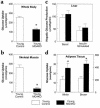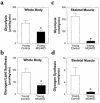Glucose toxicity and the development of diabetes in mice with muscle-specific inactivation of GLUT4
- PMID: 11435467
- PMCID: PMC353719
- DOI: 10.1172/JCI10294
Glucose toxicity and the development of diabetes in mice with muscle-specific inactivation of GLUT4
Abstract
Using cre/loxP gene targeting, transgenic mice with muscle-specific inactivation of the GLUT4 gene (muscle GLUT4 KO) were generated and shown to develop a diabetes phenotype. To determine the mechanism, we examined insulin-stimulated glucose uptake and metabolism during hyperinsulinemic-euglycemic clamp in control and muscle GLUT4 KO mice before and after development of diabetes. Insulin-stimulated whole body glucose uptake was decreased by 55% in muscle GLUT4 KO mice, an effect that could be attributed to a 92% decrease in insulin-stimulated muscle glucose uptake. Surprisingly, insulin's ability to stimulate adipose tissue glucose uptake and suppress hepatic glucose production was significantly impaired in muscle GLUT4 KO mice. To address whether these latter changes were caused by glucose toxicity, we treated muscle GLUT4 KO mice with phloridzin to prevent hyperglycemia and found that insulin-stimulated whole body and skeletal muscle glucose uptake were decreased substantially, whereas insulin-stimulated glucose uptake in adipose tissue and suppression of hepatic glucose production were normal after phloridzin treatment. In conclusion, these findings demonstrate that a primary defect in muscle glucose transport can lead to secondary defects in insulin action in adipose tissue and liver due to glucose toxicity. These secondary defects contribute to insulin resistance and to the development of diabetes.
Figures





Similar articles
-
Adipose-specific overexpression of GLUT4 reverses insulin resistance and diabetes in mice lacking GLUT4 selectively in muscle.Am J Physiol Endocrinol Metab. 2005 Oct;289(4):E551-61. doi: 10.1152/ajpendo.00116.2005. Epub 2005 May 31. Am J Physiol Endocrinol Metab. 2005. PMID: 15928024
-
Peripheral but not hepatic insulin resistance in mice with one disrupted allele of the glucose transporter type 4 (GLUT4) gene.J Clin Invest. 1997 Oct 1;100(7):1831-9. doi: 10.1172/JCI119711. J Clin Invest. 1997. PMID: 9312184 Free PMC article.
-
Nonobese, insulin-deficient Ins2Akita mice develop type 2 diabetes phenotypes including insulin resistance and cardiac remodeling.Am J Physiol Endocrinol Metab. 2007 Dec;293(6):E1687-96. doi: 10.1152/ajpendo.00256.2007. Epub 2007 Oct 2. Am J Physiol Endocrinol Metab. 2007. PMID: 17911348
-
Effects of hyperglycemia on glucose transporters of the muscle: use of the renal glucose reabsorption inhibitor phlorizin to control glycemia.J Am Soc Nephrol. 1992 Nov;3(5):1078-91. doi: 10.1681/ASN.V351078. J Am Soc Nephrol. 1992. PMID: 1482748 Review.
-
GLUT4: a key player regulating glucose homeostasis? Insights from transgenic and knockout mice (review).Mol Membr Biol. 2001 Jul-Sep;18(3):205-11. doi: 10.1080/09687680110072131. Mol Membr Biol. 2001. PMID: 11681787 Review.
Cited by
-
Sirt3 regulates metabolic flexibility of skeletal muscle through reversible enzymatic deacetylation.Diabetes. 2013 Oct;62(10):3404-17. doi: 10.2337/db12-1650. Epub 2013 Jul 8. Diabetes. 2013. PMID: 23835326 Free PMC article.
-
Muscle-specific knockout of PKC-lambda impairs glucose transport and induces metabolic and diabetic syndromes.J Clin Invest. 2007 Aug;117(8):2289-301. doi: 10.1172/JCI31408. J Clin Invest. 2007. PMID: 17641777 Free PMC article.
-
Inflammation and insulin resistance: an old story with new ideas.Korean Diabetes J. 2010 Jun;34(3):137-45. doi: 10.4093/kdj.2010.34.3.137. Epub 2010 Jun 30. Korean Diabetes J. 2010. PMID: 20617073 Free PMC article.
-
Sarcopenic Obesity, Insulin Resistance, and Their Implications in Cardiovascular and Metabolic Consequences.Int J Mol Sci. 2020 Jan 13;21(2):494. doi: 10.3390/ijms21020494. Int J Mol Sci. 2020. PMID: 31941015 Free PMC article. Review.
-
Changes in Weight and Glucose Can Protect Against Progression in Early Diabetes Independent of Improvements in β-Cell Function.J Clin Endocrinol Metab. 2016 Nov;101(11):4076-4084. doi: 10.1210/jc.2016-2056. Epub 2016 Aug 17. J Clin Endocrinol Metab. 2016. PMID: 27533307 Free PMC article. Clinical Trial.
References
-
- Warram JH, Martin BC, Krolewski AS, Soeldner JS, Kahn CR. Slow glucose removal rate and hyperinsulinemia precede the development of type II diabetes in the offspring of diabetic patients. Ann Intern Med. 1990;113:909–915. - PubMed
-
- Reaven GM, Bernstein R, Davis B, Olefsky JM. Nonketotic diabetes mellitus: insulin deficiency or insulin resistance? Am J Med. 1976;60:80–88. - PubMed
-
- DeFronzo RA. The triumvirate: beta-cell, muscle, liver. A collusion responsible for NIDDM. Diabetes. 1988;37:667–687. - PubMed
-
- Shulman GI, et al. Quantitation of muscle glycogen synthesis in normal subjects and subjects with non-insulin-dependent diabetes by 13C nuclear magnetic resonance spectroscopy. N Engl J Med. 1990;322:223–228. - PubMed
-
- DeFronzo RA, et al. The effect of insulin on the disposal of intravenous glucose. Results from indirect calorimetry and hepatic and femoral venous catheterization. Diabetes. 1981;30:1000–1007. - PubMed
Publication types
MeSH terms
Substances
Grants and funding
LinkOut - more resources
Full Text Sources
Medical
Molecular Biology Databases
Research Materials

